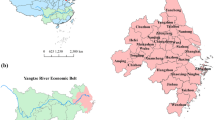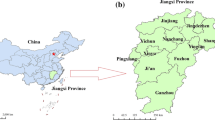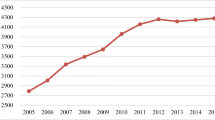Abstract
To achieve a win–win situation for both urbanization and carbon emissions reduction from a spatiotemporal perspective, we need to identify the salient links between urbanization and carbon emissions in different dimensions. Using 2008–2018 panel data on the Yangtze River Delta urban agglomeration, this paper constructs a Stochastic Impacts by Regression on Population, Affluence, and Technology (STIRPAT) model based on four dimensions of urbanization: population, economy, land, and ecology. Additionally, it uses a whole group of variables for reference, constructs a Spatial Durbin model (SDM) to estimate the spatial effect, and empirically investigates the spatial dependence of carbon emissions and the influence of various driving factors. The results show that (1) in the temporal dimension, the historical carbon emissions of the study area continue to increase. However, the extent to which they are doing so is slowing, the number of low carbon emissions areas has significantly decreased, the number of medium carbon emissions areas have significantly increased, the number of high and relatively high carbon emissions areas are relatively stable, and energy intensity continues to decline. (2) In the spatial dimension, Shanghai, Suzhou, and their surrounding cities have always been carbon emissions hotspots, high and relatively high carbon emissions areas are mainly concentrated in these cities. Low carbon emissions areas and cold spots are mainly distributed in Anhui Province. Medium carbon emissions areas show a great spatial and temporal evolution and are distributed in all provinces. (3) In the four dimensions of urbanization, per capita GDP will not only affect regional carbon emissions but also have a spatial spillover effect. For every 1% increase in the economic factors, carbon emissions in neighboring regions will increase by 0.38–0.43%. Population, economic, and technological factors have significant positive effects on carbon emissions, and economic factor is the most important factor. (4) In different dimensions of urbanization, there are obvious heterogeneities in the impacts of different factors on carbon emissions. Among them, the elasticity coefficient of per capita GDP and energy intensity is the smallest among the dimension of land urbanization, and the elasticity coefficient of the total population is the smallest among the dimension of population urbanization. Therefore, when formulating carbon emissions reduction policies, it is necessary to fully consider the spatial spillover effects, determine the optimal population size threshold, advocate for a low-carbon lifestyle, promote clean technology, and realize information exchange and policy interaction across regions from the perspective of holistic governance.




Similar content being viewed by others
Data availability
The datasets used and/or analyzed during the current study are available from the corresponding author on reasonable request.
References
Adams S, Boateng E, Acheampong AO (2020) Transport energy consumption and environmental quality: Does urbanization matter? Sci Total Environ 744:140617. https://doi.org/10.1016/j.scitotenv.2020.140617
Ahmad M, Zhao ZY (2018) Empirics on linkages among industrialization, urbanization, energy consumption, CO2 emissions and economic growth: a heterogeneous panel study of China. Environ Sci Pollut Res 25:30617–30632. https://doi.org/10.1007/s11356-018-3054-3
Chen J, Wang L, Li Y (2020) Research on the impact of multi-dimensional urbanization on China’s carbon emissions under the background of COP21. J Environ Manage 273:111–123. https://doi.org/10.1016/j.jenvman.2020.111123
Chen S, Jin H, Lu Y (2019) Impact of urbanization on CO2 emissions and energy consumption structure: A panel data analysis for Chinese prefecture-level cities. Struct Change Econ D 49:107–119. https://doi.org/10.1016/j.strueco.2018.08.009
Dietz T, Rosa EA (1997) Effects of population and affluence on CO2 emissions. P Natl A Sci USA 94:175–179. https://doi.org/10.1073/pnas.94.1.175
Du Y, Wan Q, Liu H, Liu H, Kasper K, Peng J (2019) How does urbanization influence PM2.5 concentrations? Perspective of spillover effect of multi-dimensional urbanization impact. J Clean Prod 220:974–983. https://doi.org/10.1016/j.jclepro.2019.02.222
Ehrlich PR, Holdren JP (1971) Impact of population growth. Science 171:1212–1217
He J, Wang S, Liu Y, Ma H, Liu Q (2017) Examining the relationship between urbanization and the eco-environment using a coupling analysis: Case study of Shanghai, China. Ecol Indic 77:185–193. https://doi.org/10.1016/j.ecolind.2017.01.017
Hong J, Gu J, He R, Wang X, Shen Q (2020) Unfolding the spatial spillover effects of urbanization on interregional energy connectivity: evidence from province-level data. Energy 196:1–31. https://doi.org/10.1016/j.energy.2020.116990
Huang H, Qiao X, Zhang J, Li Y, Zeng Y (2019) Spatial temporal differentiation and influencing factors of regional tourism carbon emissions under the background of green development: a case study of the Yangtze River economic belt. Econ geogr 39:214–224
Li J, Li S (2020) Energy investment, economic growth and carbon emissions in China—Empirical analysis based on spatial Durbin model. Energy Policy 140:111425. https://doi.org/10.1016/j.enpol.2020.111425
Li Z, Li Y, Shao S (2019) Analysis of Influencing Factors and Trend Forecast of Carbon Emission from Energy Consumption in China Based on Expanded STIRPAT Model. Energies 12:30–44. https://doi.org/10.3390/en12163054
Liddle B, Lung S (2010) Age-structure, urbanization, and climate change in developed countries: revisiting STIRPAT for disaggregated population and consumption-related environmental impacts. Popul Environ 31:317–343. https://doi.org/10.1007/s11111-010-0101-5
Liu F, Liu C (2019) Regional disparity, spatial spillover effects of urbanisation and carbon emissions in China. J Clean Prod 241:118226. https://doi.org/10.1016/j.jclepro.2019.118226
Liu N, Liu C, Xia Y, Da B (2018) Examining the coordination between urbanization and eco-environment using coupling and spatial analyses: A case study in China. Ecol Indic 93:1163–1175. https://doi.org/10.1016/j.ecolind.2018.06.013
Liu Y, Xiao H, Zikhali P, Lv Y (2014) Carbon Emissions in China: A Spatial Econometric Analysis at the Regional Level. Sustainability 6(9):6005–6023. https://doi.org/10.3390/su6096005
Martínez-Zarzoso I, Maruotti A (2011) The Impact of Urbanization on CO2 Emissions: Evidence from Developing Countries. Ecol Econ 70:1344–1353. https://doi.org/10.1016/j.ecolecon.2011.02.009
Shi L, Cai Z, Ding X, Di R, Xiao Q (2020) What Factors Affect the Level of Green Urbanization in the Yellow River Basin in the Context of New-Type Urbanization? Sustainability 12(6):2488–2503. https://doi.org/10.3390/su12062488
Song Z (2021) Economic growth and carbon emissions: Estimation of a panel threshold model for the transition process in China. J Clean Prod 278:123773. https://doi.org/10.1016/j.jclepro.2020.123773
Sadorsky P (2014) The effect of urbanization on CO2 emissions in emerging economies. Energ Econ 41:147–153. https://doi.org/10.1016/j.eneco.2013.11.007
Sharma SS (2011) Determinants of carbon dioxide emissions: Empirical evidence from 69 countries. Appl Energ 88:376–382. https://doi.org/10.1016/j.apenergy.2010.07.022
Wang F, Fan W, Liu J, Wang G, Chai W (2020) The effect of urbanization and spatial agglomeration on carbon emissions in urban agglomeration. Environ Sci Pollut Res 8:1–13. https://doi.org/10.1007/s11356-020-08597-4
Wang F, Qin Y, Liu J, Wu C (2017) Research on the influencing factors of carbon emissions from the perspective of multi-dimensional Urbanization: a spatial Durbin panel model based on China's provincial data. China's population, resources and environment 27(9):151–161. https://doi.org/10.12062/cpre.20170434 (In Chinese)
Yang L, Xia H, Zhang X, Yuan S (2018) What matters for carbon emissions in regional sectors? A China study of extended STIRPAT model. J Clean Prod 180:595–602. https://doi.org/10.1016/j.jclepro.2018.01.116
Yilmaz S, Sezen I, Sari EN (2021) The relationships between ecological urbanization, green areas, and air pollution in Erzurum/Turkey. Environ Ecol Stat 9:004846
Yu X, Wu Z, Zheng H, Li M, Tan T (2020) How urban agglomeration improve the emission efficiency? A spatial econometric analysis of the Yangtze River Delta Urban Agglomeration in China. J Environ Manage 263:260–268. https://doi.org/10.1016/j.jenvman.2019.110061
Yang Y, Li J, Zhu G, Guan X, Zhu W (2020) The impact of multi-dimensional urbanization on PM2.5 concentrations in 261 cities of China. IEEE Access 99:96199–96209. https://doi.org/10.1109/access.2020.2995507
Zhang S, Zhao T (2019) Identifying major influencing factors of CO2 emissions in China: Regional disparities analysis based on STIRPAT model from 1996 to 2015. Atmos Environ 207:136–147. https://doi.org/10.1016/j.atmosenv.2018.12.040
Zhao DL, Li T (2016) Variation characteristics and influencing factors of carbon emissions in the process of urbanization in China. Journal of Peking University (Natural Science Edition) 52:947–958. https://doi.org/10.13209/j.0479-8023.2016.060 (In Chinese)
Zhou C, Wang S, Wang J (2019) Examining the influences of urbanization on carbon dioxide emissions in the Yangtze River Delta, China: Kuznets curve relationship. Sci Total Environ 675:472–482. https://doi.org/10.1016/j.scitotenv.2019.04.269
Funding
This study was supported by the National Natural Science Foundation of China (No. 71864016), the Postdoctoral Science Foundation of China (No. 2017M622098), the Jiangxi Postdoctoral Science Foundation (No.2017KY55), the Postdoctoral Daily Funding of Jiangxi Province (No. 2017RC036), the Science and Technology Project of Jiangxi Education Department (No. GJJ200509 & GJJ200542), the Humanities and Social Sciences Project of Jiangxi Education Department (No. JC20201), the Educational Science Planning of Jiangxi Province (No. 21YB042), Special Fund Project for Graduate Innovation in Jiangxi Province (No. YC2021–S384), and the 16th Student Scientific Research Project of Jiangxi University of Finance and Economics (No. 20210913204025738).
Author information
Authors and Affiliations
Contributions
Tiangui Lv and Han Hu analyzed the data and wrote the original manuscript. Han Hu and Li Wang performed the experiments. Tiangui Lv, Xinmin Zhang, and Hualin Xie gave the direction of research and reviewed the manuscript. Xinmin Zhang and Shufei Fu revised the manuscript.
Corresponding author
Ethics declarations
Ethics approval and consent to participate
Not applicable.
Consent for publication
Not applicable.
Competing interests
The authors declare no competing interests.
Additional information
Responsible Editor: Eyup Dogan.
Publisher's note
Springer Nature remains neutral with regard to jurisdictional claims in published maps and institutional affiliations.
Rights and permissions
About this article
Cite this article
Lv, T., Hu, H., Zhang, X. et al. Spatial spillover effects of urbanization on carbon emissions in the Yangtze River Delta urban agglomeration, China. Environ Sci Pollut Res 29, 33920–33934 (2022). https://doi.org/10.1007/s11356-021-17872-x
Received:
Accepted:
Published:
Issue Date:
DOI: https://doi.org/10.1007/s11356-021-17872-x




